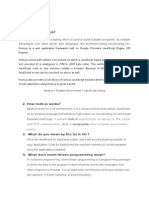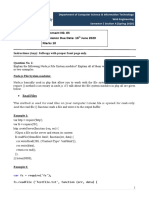0% found this document useful (0 votes)
31 views4 pagesNodejs Basic Questions
The document provides an overview of Node.js, explaining its purpose as a JavaScript engine for backend development, its differences from JavaScript, and its single-threaded nature. It covers key concepts such as synchronous and asynchronous functions, modules, npm, middleware, event loops, and control flow, as well as the advantages and disadvantages of using Node.js. Additionally, it includes practical examples like writing a 'Hello World' program and mentions the popular Express.js framework and the concept of promises in Node.js.
Uploaded by
vinupriyatpcCopyright
© © All Rights Reserved
We take content rights seriously. If you suspect this is your content, claim it here.
Available Formats
Download as DOCX, PDF, TXT or read online on Scribd
0% found this document useful (0 votes)
31 views4 pagesNodejs Basic Questions
The document provides an overview of Node.js, explaining its purpose as a JavaScript engine for backend development, its differences from JavaScript, and its single-threaded nature. It covers key concepts such as synchronous and asynchronous functions, modules, npm, middleware, event loops, and control flow, as well as the advantages and disadvantages of using Node.js. Additionally, it includes practical examples like writing a 'Hello World' program and mentions the popular Express.js framework and the concept of promises in Node.js.
Uploaded by
vinupriyatpcCopyright
© © All Rights Reserved
We take content rights seriously. If you suspect this is your content, claim it here.
Available Formats
Download as DOCX, PDF, TXT or read online on Scribd
/ 4































































































